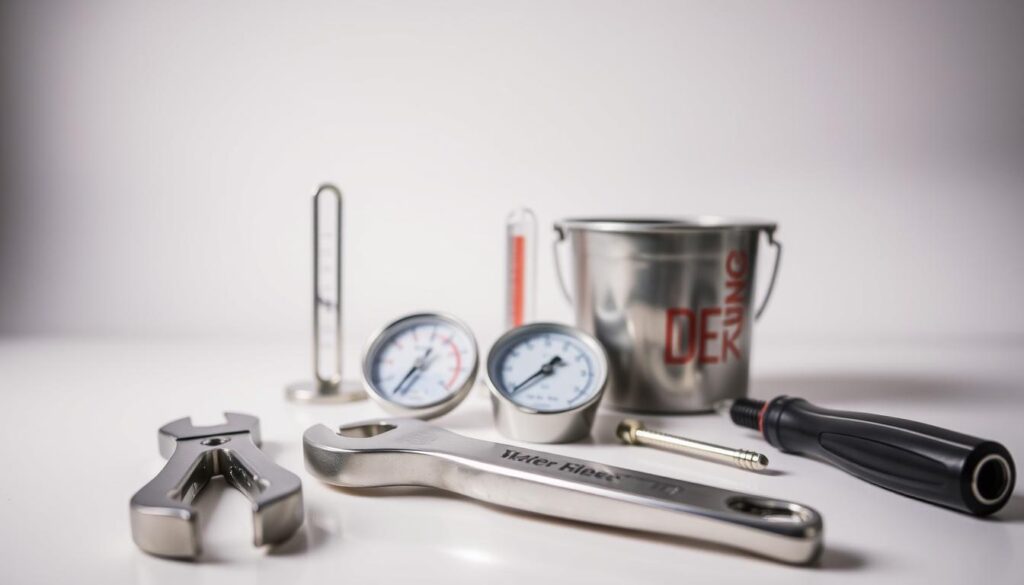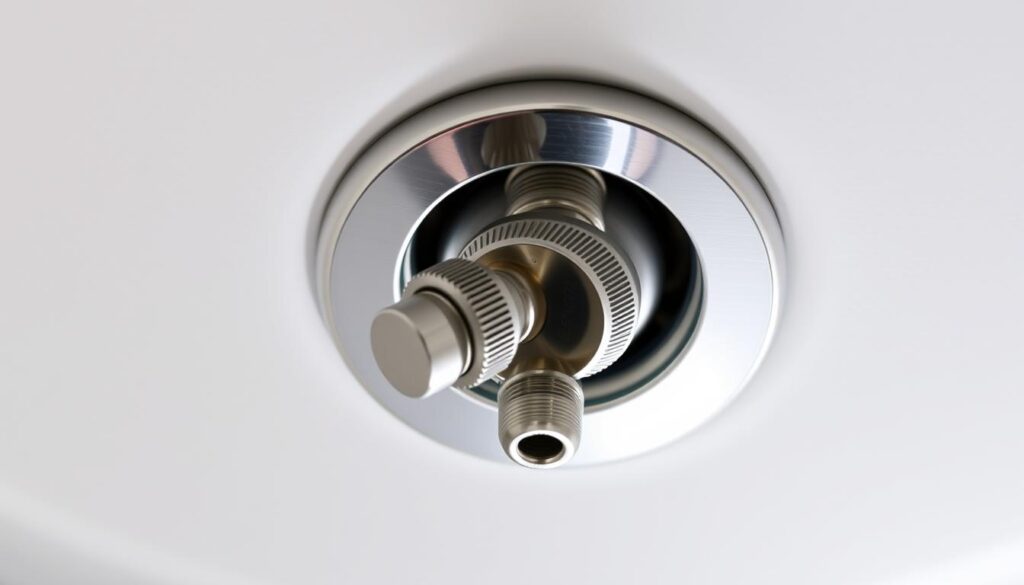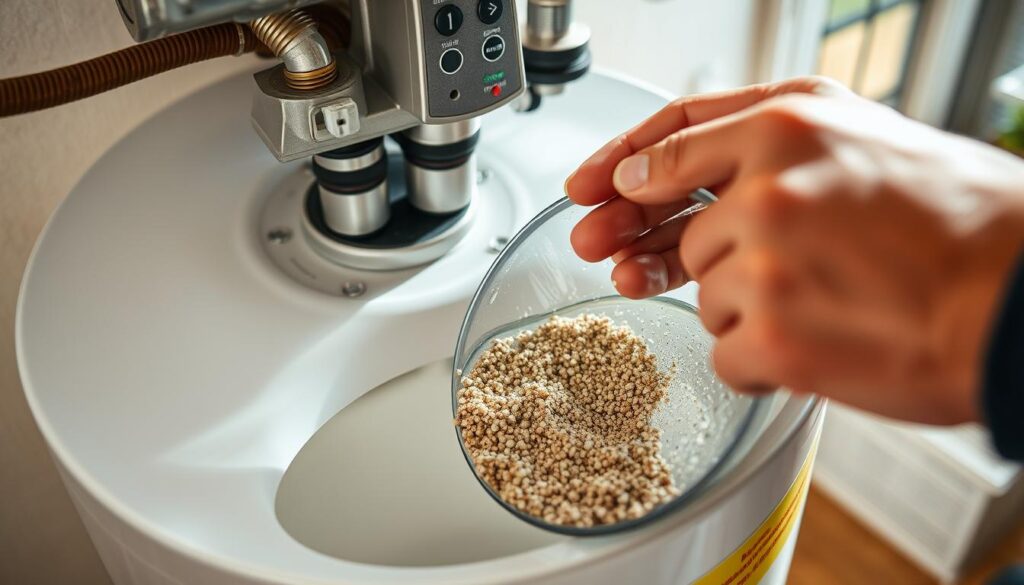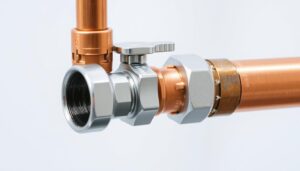Are you experiencing reduced efficiency from your water heater, or are your energy bills creeping up without explanation? The culprit might be sediment buildup in your tank. Sediment accumulation is a common issue affecting water heaters across the UK, potentially leading to increased energy costs and system damage.
Regular maintenance of your heating system, including your water heater, is crucial for optimal performance and preventing costly repairs. Understanding how sediment affects your water heating system is the first step towards maintaining an efficient home solution.
Key Takeaways
- Regular maintenance can improve the efficiency of your water heater.
- Sediment buildup can lead to increased energy bills.
- Clearing sediment can extend the lifespan of your water heater.
- Understanding sediment’s impact is crucial for maintaining your heating system.
- Proper maintenance can prevent costly repairs or replacements.
Why Sediment Builds Up in Hot Water Tanks
Understanding why sediment accumulates in hot water tanks is crucial for maintaining your water heater’s efficiency. Over time, minerals from the water can settle at the bottom of the tank, forming sediment.
This sediment buildup can be attributed to the presence of minerals such as calcium and magnesium in the water, which are common in hard water areas. As the water is heated, these minerals precipitate out and settle at the bottom of the tank.
Signs Your Hot Water Tank Has Sediment Buildup
If you’re experiencing reduced hot water supply or your water heater is making unusual noises, it could be a sign of sediment buildup. Other indicators include:
- Reduced hot water availability
- Unusual noises from the water heater
- Increased energy bills
The Dangers of Ignoring Sediment Buildup
Ignoring sediment buildup can have severe consequences, including:
- Premature failure of your water heater
- Increased energy consumption
- Reduced heating efficiency
- Potential for tank leaks or failure
The following table summarises the potential issues caused by sediment buildup:
| Issue | Consequence |
|---|---|
| Sediment buildup | Premature water heater failure |
| Increased energy consumption | Higher utility bills |
| Reduced heating efficiency | Less hot water available |
Tools and Materials You’ll Need for the Job
Before you start clearing sediment from your hot water tank, it’s essential to gather the necessary tools and materials. Having the right equipment ensures a safe and efficient process.
Essential Equipment for Sediment Removal
To remove sediment effectively, you’ll need a few key pieces of equipment. A garden hose is necessary for draining the tank, and a pump may be required if the sediment is particularly stubborn. Ensure that your equipment is compatible with your water heater type, whether it’s electric or gas.
Safety Gear Requirements
Safety should be your top priority when working with hot water tanks. Heat-resistant gloves and eye protection are crucial for protecting yourself from hot surfaces and potential splashes. Additionally, closed-toe shoes with non-slip soles can prevent accidents caused by slipping on wet surfaces. If your water heater uses gas, a flashlight can be handy for checking pilot lights or gas connections. For electric water heaters, a voltage tester ensures the power is off before you start work.

Preparing Your Hot Water Tank for Maintenance
To ensure a safe and effective sediment removal process, your hot water tank needs to be prepared correctly. This involves a few crucial steps to prevent any accidents or complications during maintenance.
Turning Off the Power Supply
Before starting the maintenance, you must turn off the power supply to your water heater. This is a critical safety measure to prevent any electrical shocks or accidents. Locate the circuit breaker or fuse that controls the power to your water heater and switch it off.
Shutting Off the Water Supply
To stop water from entering the tank during maintenance, you need to shut off the cold water supply. Locate the cold water supply valve, typically found on the pipe entering the top of your water heater, and turn it clockwise until it’s completely closed. Then, open a hot water tap somewhere in your home to relieve pressure in the system. This step is crucial to prevent vacuum formation in the pipes.
| Step | Action | Purpose |
|---|---|---|
| 1 | Turn off power supply | Prevent electrical shocks |
| 2 | Shut off cold water supply | Stop water from entering the tank |
| 3 | Open a hot water tap | Relieve pressure in the system |
How to Clear Sediment from Hot Water Tank
Clearing sediment from your hot water tank involves a few simple steps that can significantly improve its performance. To start, you’ll need to connect a drain hose to the drain valve at the bottom of the tank.
Connecting the Drain Hose Properly
Ensure the hose is securely attached to the drain valve to prevent leaks. The other end should be placed in a suitable drainage area, such as a floor drain or outside.
Draining the Tank Completely
Open the drain valve to allow the water to flow out. You may need to let it drain completely or until the water runs clear, depending on the sediment level. Be cautious as the water may be hot.

Dealing with Clogged Drain Valves
Sediment can clog the drain valve, particularly in tanks that haven’t been maintained regularly. If the water flow is minimal or stops, try closing the valve, disconnecting the hose, and clearing the valve opening with a small wire. For stubborn clogs, you may need to use the backflush method or consult a professional plumber.
Clearing sediment from your water heater is crucial for maintaining its efficiency and prolonging its lifespan. Regular maintenance can help prevent severe sediment buildup and the need for costly repairs or replacement.
Flushing the Tank to Remove Remaining Sediment
After draining your hot water tank, the next crucial step is flushing it to remove any remaining sediment. This process involves running water through the tank to dislodge and remove any stubborn sediment that may have been left behind during the initial draining.
The Backflush Method for Stubborn Sediment
For tanks with particularly stubborn sediment, the backflush method can be highly effective. This involves connecting a hose to the drain valve and running water into the tank in the reverse direction, helping to dislodge any remaining sediment. It’s a technique often used by professional plumbers when dealing with heavily sedimented water heaters.
How to Know When Your Tank is Clean
Determining when your tank is clean involves observing the water flowing from the drain valve. The most reliable indicator is clear water without visible particles. You can collect water in a white bucket periodically during the flushing process to better observe its clarity. When sediment is fully removed, the water should appear clear rather than cloudy, rusty, or discoloured. Additionally, a clean tank typically produces less rumbling or gurgling noise.
| Indicator | Description |
|---|---|
| Clear Water | Water flowing from the drain valve is clear without visible particles. |
| Reduced Noise | The tank produces less rumbling or gurgling noise once clean. |
| Multiple Flush Cycles | Most residential tanks require 3-5 complete flush cycles to remove all significant sediment deposits. |
It’s recommended to continue the flushing process until the water has been clear for at least two consecutive flushes. The time required for complete cleaning varies greatly depending on tank size and the severity of sediment accumulation.
Refilling and Restarting Your Hot Water Tank
After successfully draining the sediment from your hot water tank, you can proceed to refill and restart it. This step is crucial to get your hot water system operational again.
Proper Refilling Technique
To refill your hot water tank, open the cold water supply valve slowly to allow water to flow into the tank. It’s essential to check for any leaks around the tank and its connections during this process. Ensure the tank is completely full before proceeding to the next step.
Turning the Power Back On Safely
Before restoring power, confirm that your water heater is full. For electric water heaters, reset the dedicated circuit breaker. For gas water heaters, relight the pilot light following the manufacturer’s instructions. Set the thermostat to your desired temperature, typically between 49-60°C. Listen for normal operating sounds as your hot water heater begins working. For gas heaters, check that the main burner ignites properly.
Be aware that the initial heating cycle may take longer than usual. Some modern water heaters have specific restart procedures, so consult your owner’s manual if necessary.
Conclusion: Maintaining Your Hot Water Tank
A well-maintained hot water tank is essential for your home’s comfort and energy efficiency. Regular maintenance of your water heater is crucial for optimal performance, energy efficiency, and longevity. To achieve this, it’s recommended to flush sediment from your water heater at least once per year, or more frequently if you have particularly hard water.
Creating a regular maintenance schedule helps prevent excessive sediment buildup, making the process easier and less time-consuming. Many homeowners find it beneficial to perform this maintenance seasonally. For instance, doing it at the beginning of autumn prepares your hot water heater for the increased demands of winter.
While DIY maintenance is beneficial, consider hiring a plumber for more thorough maintenance services, including inspections of safety features and components. Additionally, installing a water softener can significantly reduce sediment formation if you have hard water. By investing time in regular maintenance, you can extend your water heater’s lifespan by many years.



